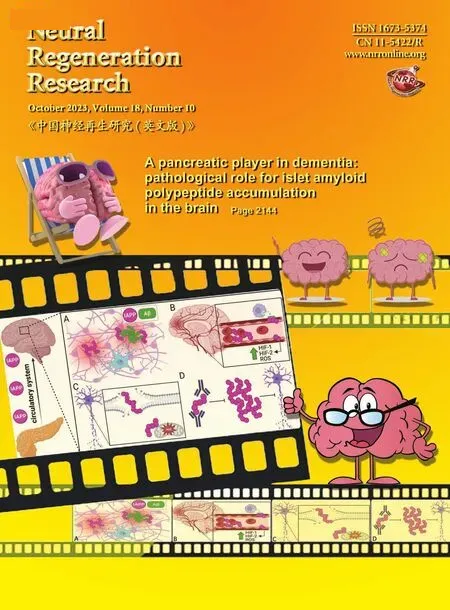中國神經再生研究(英文版)
Reviews
- From static to dynamic: live observation of the support system after ischemic stroke by two photon-excited fluorescence laser-scanning microscopy
- MicroRNAs in mouse and rat models of experimental epilepsy and potential therapeutic targets
- The generation and properties of human cortical organoids as a disease model for malformations of cortical development
- Nanotechnology-based gene therapy as a credible tool in the treatment of Alzheimer’s disease
- Detection of Alzheimer’s disease onset using MRI and PET neuroimaging: longitudinal data analysis and machine learning
- A pancreatic player in dementia: pathological role for islet amyloid polypeptide accumulation in the brain
- The role of fibronectin in multiple sclerosis and the effect of drug delivery across the blood-brain barrier
- Alexander disease: the road ahead
- Mitochondrial dysfunction as a target in spinal cord injury: intimate correlation between pathological processes and therapeutic approaches
- The role of Rho GTPase family in cochlear hair cells and hearing
- Oxidative stress in retinal pigment epithelium degeneration: from pathogenesis to therapeutic targets in dry age-related macular degeneration
Research Articles
- Astrocyte-neuron communication mediated by the Notch signaling pathway: focusing on glutamate transport and synaptic plasticity
- Exosomes derived from human umbilical cord mesenchymal stem cells alleviate Parkinson’s disease and neuronal damage through inhibition of microglia
- Neuroprotective effect of mesenchymal stem cellderived extracellular vesicles on optic nerve injury in chronic ocular hypertension
- Srgap2 suppression ameliorates retinal ganglion cell degeneration in mice
- Adipose mesenchymal stem cell-derived extracellular vesicles reduce glutamate-induced excitotoxicity in the retina
- M2 macrophages mediate fibrotic scar formation in the early stages after cerebral ischemia in rats
- Eph receptor A4 regulates motor neuron ferroptosis in spinal cord ischemia/reperfusion injury in rats
- Reperfusion after hypoxia-ischemia exacerbates brain injury with compensatory activation of the anti-ferroptosis system: based on a novel rat model
- The circular RNA Rap1bpromotes Hoxa5transcription by recruiting Kat7 and leading to increased Fam3aexpression, which inhibits neuronal apoptosis in acute ischemic stroke
- Exosomes from bone marrow mesenchymal stem cells are a potential treatment for ischemic stroke
- Substance P promotes epidural fibrosis via induction of type 2 macrophages
- A new peptide, VD11, promotes structural and functional recovery after spinal cord injury
- Characteristics of traumatic brain injury models:from macroscopic blood flow changes to microscopic mitochondrial changes
- TUG-891 inhibits neuronal endoplasmic reticulum stress and pyroptosis activation and protects neurons in a mouse model of intraventricular hemorrhage
Perspectives
- Boosting corticospinal system synaptic plasticity to recover motor functions
- Stable isotope labeling-mass spectrometry as a new approach to determine remyelination
- Regulation of cytohesins by their interactors in the nervous system
- Pediatric GNAO1encephalopathies:from molecular etiology of the disease to drug discovery
- A perspective on recent findings and future strategies for reactive aldehyde removal in spinal cord injury
- Disease-associated oligodendrocyte signatures in neurodegenerative disease: the known and unknown
- Repurposing ibrutinib: therapeutic effects and implications for translational approaches in Alzheimer’s disease
- Metabotropic glutamate receptor 1 alpha: a unique receptor variant with variable implications for Alzheimer’s disease pathogenesis
- Multi-faceted small molecule for Alzheimer’s disease
- Reevaluating the cause of laminopathy in Alzheimer’s disease
- The importance of being connected:membrane contact sites and Parkinson’s disease
- Clues from a missense mutation of the adenosine A1receptor gene associated with early-onset Parkinson’s disease
- Renin-angiotensin system in the central nervous system: focus on Huntington’s disease

